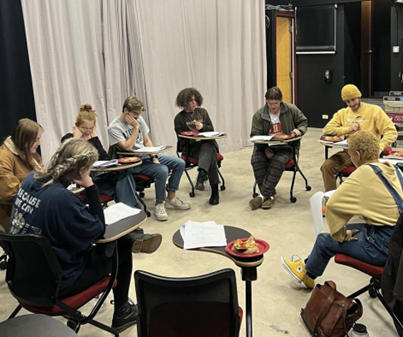Every once in a while, a new book hits the shelves and all of a sudden becomes a notable sensation. Readers start to wonder why and how the book has become an immediate success, so they read and they talk. Word about the book passes through the public like a train, rushing through readers who whiz through the pages and slowing down at the station for discussion, before taking off again towards the next stop. It seems appropriate that the latest sensation is the thriller “The Girl on the Train” by Paula Hawkins.
Rachel is a passenger on the train that makes its way from Ashbury to London in the morning, and from London back to Ashbury in the evening. She can see into the backyards of a string of houses along the railway and her favorite backyard is that of people she’s named Jess and Jason. The couple is young, in love and perfectly happy with everything in their life, just as Rachel used to be in years prior. Now, she’s depressed, unemployed and struggling with alcoholism.
This fantasy life comes crashing down on the morning Rachel sees something shocking in the momentary pause of the train. She involves herself in the actual world of the couple, Megan and Scott, who happen to live only a few doors down from Rachel’s cheating ex-husband Tom, his new wife Anna and their baby Evie. To make matters worse, Megan suddenly disappears and Rachel may be the one person who knows what happened, if only a large part of that night wasn’t blacked out and full of flashes that don’t make sense.
Hawkins has produced an intriguing story that keeps readers on their toes, thanks to the variation in narration. The point of view is altered, constantly switching between the perspectives of Rachel, Megan and Anna. This alteration forces the reader to pay attention to who is speaking in order to understand where certain puzzle pieces are coming from, but there is little difference between the voices of these three separate characters. Each woman has her own background and story, but more often than not their narrations tend to blend together because the women sound so similar.
Though they each have their own issues, their personalities seem somewhat the same. If a reader doesn’t pay attention to the specifically noted character switches, it would be easy to get lost and confused.
Strangely, some of the ideas in the novel that seem to be weaknesses are also sources of strength. For example, the novel is constructed by inclusions of the specific day and the name of the narrator for the section that follows. Each narrator breaks the day into ‘morning’ and ‘evening’. This structure carries the idea of the systemic regularity of the train that Rachel rides every morning and evening, creating an interesting and unique parallel through which to tell the mystery.
However, this strength could also be seen as a weakness because it limits the scope of the story, making it seem as if anything notable only ever happened in the ‘morning’ or in the ‘evening.’
Simultaneous strength and weakness are present in the narration. All three narrators are incredibly unreliable: Rachel is an alcoholic, Megan isn’t mentally stable and Anna has extreme emotions and paranoia. None of them can accurately depict an event, and it is difficult to know if any of them are telling the truth or if they are delusional or if they are being manipulative.
On one hand, this strengthens the story because it keeps the reader guessing and grasping at straws, wondering whom, if any of them, can be trusted. Still, it is also frustrating because the reader is left unfulfilled at the end. Even when it seems all logical questions have been answered, the reader is still taunted by the questions of doubt and uncertainty as a result of the unreliable narrators.
“The Girl on the Train” is captivating, thrilling and frustrating all at once. Still, be warned: if you choose to read this novel, be prepared to have questions and ensure that someone you know will be willing to discuss it with you because the mystery doesn’t necessarily end once the back cover is closed.Paula Hawk











